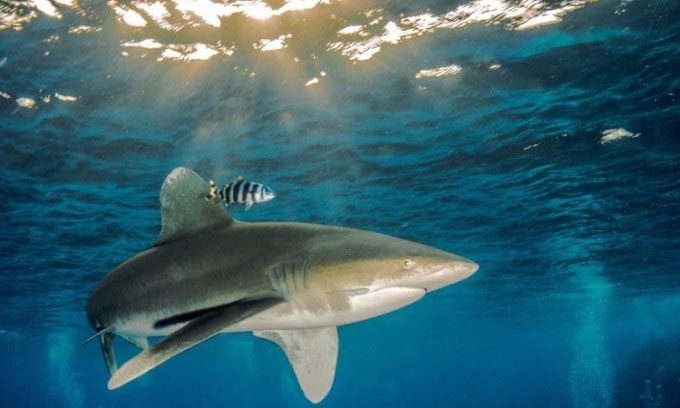The USS Indianapolis, a U.S. Navy ship, sank during World War II, leading to one of the deadliest shark attack incidents in history, resulting in the deaths of 150 people.
Shark attacks are extremely rare. However, during World War II, the sinking of the USS Indianapolis sparked the most notorious shark attack tragedy in history. The explosion drew predatory species to the scene, igniting a multi-day massacre, according to Live Science.
In July 1945, the USS Indianapolis completed a mission to the naval base on Tinian Island in the Pacific to transport uranium and various components used in the creation of the atomic bomb “Little Boy“. This was the first nuclear weapon used in war and was later dropped by the U.S. military on the city of Hiroshima in Japan.

White tip sharks usually live near the surface. (Image: atese).
After delivering the materials, the Indianapolis set sail for the Philippines to participate in a training mission. Shortly after midnight on July 30, the ship was struck by a torpedo from a Japanese submarine, causing significant damage. A massive amount of water flooded into the USS Indianapolis, causing the ship to sink within just 12 minutes. Of the 1,195 crew members aboard, approximately 300 went down with the ship, while nearly 900 were adrift in the open sea. Many died from exhaustion, dehydration, and saltwater poisoning. However, according to Smithsonian Magazine, an estimated 150 sailors died from shark bites.
Unlike some other predators like lions and wolves, most sharks hunt alone, according to Nico Booyens, a marine biologist and research director at the Shark Research Unit in South Africa. Different shark species have varying hunting techniques, but many sharks are solitary hunters, relying on sight, smell, and electroreception to locate prey.
Sharks also possess a special system known as the lateral line system to detect vibrations in the water. This sensory capability allows them to detect the movements of soldiers struggling to stay afloat. Once sharks locate a sailor, there is little chance of survival, especially for the injured. Survivors recount that many victims were attacked near the surface. This led to the speculation that oceanic whitetip sharks (Carcharhinus longimanus) were involved in the attacks as they inhabit surface waters.
“When sharks find prey, they often use their sharp teeth and incredibly strong jaws to tear into flesh,” Booyens shared. “Some shark species, like the tiger shark (Galeocerdo cuvier), are known for their ability to swallow prey whole, while bull sharks (Carcharhinus leucas) will attack and bite their prey multiple times until it is weakened or motionless.”
Although whitetip sharks are at the top of the food chain, their meals are scarce and often spaced apart, leading them to scavenge opportunistically. According to the Florida Museum, whitetip sharks are often the first to appear at sites of maritime disasters, which was also a major cause of death after the RMS Nova Scotia sank in 1942. This species is known to be persistent, unpredictable, and bold, making them particularly dangerous to humans.
In the case of the USS Indianapolis, the corpses of the dead and wounded became prime targets. Staff Sergeant Edgar Harrell, one of the survivors, recounted: “The first morning we encountered sharks. When soldiers were separated, the sharks targeted them. You could hear a scream that froze the blood in your veins, and then the body was dragged down, leaving only the life jacket floating.”
The soldiers were so terrified that they refrained from eating or moving for fear of becoming shark prey. According to survivor reports, one sailor opened a can of food but was surrounded by sharks, leading to a frantic feeding frenzy. “Feeding frenzies often occur when food suddenly becomes abundant, such as a large school of fish trapped in a small area. The smell of blood and the thrashing of prey can trigger the frenzy, causing sharks to rush in and compete for available food,” Booyens explained.
Multiple shark species may participate in the hunt, becoming very aggressive and attacking each other as well as their prey. However, the opportunistic feeding behavior, along with the size and strength of whitetip sharks, makes them particularly dangerous to sailors. “Feeding frenzies can be very dangerous for people in the water because sharks cannot distinguish between prey and humans,” Booyens stated.
For four consecutive days, no rescue vessels appeared. Although the U.S. Navy received reports that a Japanese submarine had sunk an American ship, the message was believed to be a ruse to lure American rescue ships into a trap. Meanwhile, survivors tried to stay afloat in groups, but under the scorching sun, many succumbed to dehydration. Others died from hypernatremia after being forced to drink seawater.
Eventually, a Navy aircraft flew over and spotted the surviving sailors from the Indianapolis signaling for help. Food, water, and life rafts were dropped for the sailors before Lieutenant Adrian Marks piloted a seaplane to rescue some from the sharks. Ultimately, the USS Cecil J. Doyle assisted in pulling the survivors from the water. In total, only 316 people survived.


















































